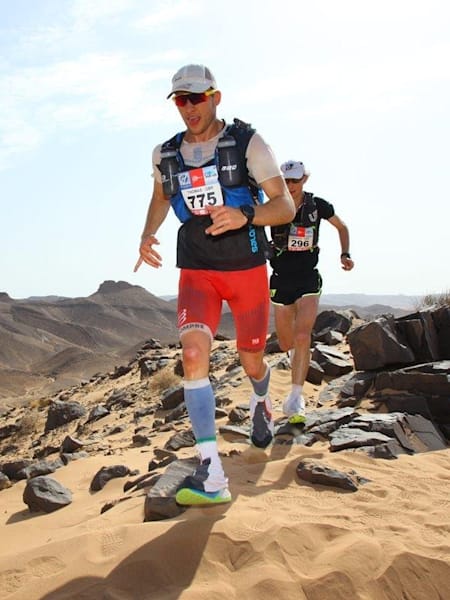Running on sand isn't a walk in the park. Well, unless that park has a lot of sand, but you know what we mean. There are tonnes of factors you need to consider such as foot position, weather condition and descent management when competing in Red Bull Quicksand. And who better to ask about it than ultra marathon star Tom Evans.
Serving with the British Army has given him a superb base level of endurance, enabling him to stay on his feet for a phenomenally long time. Oh, and he's also completed racing ultras across the Sahara desert, which helps...
1. Dig deep (literally)
"When running on sand, you want the largest surface area possible in order to avoid slipping backwards. Dig deeper into the sand. Instead of trying to land on your toes or your heel, you should just try to land on the middle of your foot to increase the surface area so you don’t sink in the sand."
2. Watch your step
"I learnt pretty quickly to read the sand itself – it’s not all the same as there might be some slightly better packed areas to tread on than others. It really helps when someone has been on the areas already because once they’ve run up it they create steps you can use. Paying attention to this will make your route a little bit easier.
The sand will be slightly compacted which just reduces the amount of energy you lose to the running. Trying to follow in someone else’s footsteps will reduce the amount of energy that you’re losing and allow you to summit the dune a bit quicker."
3. Slide away
"How you run up a dune depends massively on how steep the dune is. I like to stay nice and low over the top of the dune in order to not waste too much energy. Sometimes my hands would go down or I’d be on my knees.
As soon as you get to the top, there’s the fun bit – you just slide down the other side. I dig my heels into the sand – with my them dug in, it really saves your legs and was as quick, if not quicker method because you’re not thinking as much on your descent.
If you lead with your toe, you’re likely to trip up and have to lift your toes through fresh sand, which is just going to completely wreck your legs."
4. Prep for the weather
"With the heat and with the sun in my events, it was brutal. Light reflects off the sand so being able to see clearly is incredibly important. I wore good quality sunglasses to shade my face. I was always wearing a cap to keep the sun off my face to remain slightly cooler and so I can see better if it gets too bright.
I just wear wide lens sunglasses just to get that extra bit of visibility when I’m running into the light. It really does help being able to protect your eyes not just from the sun but from the bits of sand that your hands are going to pick up as you get sweaty."
5. And if it rains... wet sand is better
"With hard sand, the consistency is very similar to running on the road so it would be more like running normally. The dunes are always going to be soft, it doesn’t really change – maybe in between it will allow you to open up your stride a little bit more and be able to push off a little bit faster.
The faster you try to run in dry sand while being inefficient will mean the more pressure you will put onto your feet, and the more you’re going to sink into the sand, and the more energy you’re going to be using. With wet sand it will allow you to go just a little bit quicker, certainly on the flats."
6. It's all in the knees
"Because sand dunes are so steep, it’s going to be all about getting your knees really high and having that strong drive down through your core and through the front of your quad into your knee.
One really good exercise is doing step-ups which you can do in the gym and working hard by running up street hills. The dunes are very quick – it shouldn’t take you more than 15 seconds so really short sharp and intense. You can also throw in some box step ups to really increase your leg strength."
7. Choose your footwear wisely
"I think it’s a completely individual preference. I wore a pair of road shoes for the marathon which had desert gaiters attached – because you don’t want sand getting into your shoes for four hours a day.
I also think running barefoot, if you’re used to it, is a great option – it’ll feel great under your toes and you’ll feel more at one with nature. It’s a very viable option – if I was running I’d wear shoes, probably lightweight trail shoes but I think whatever’s comfortable for anyone.
Just don't overthink it. Yes, the terrain is the slightly different and not what most runners will be used to, but the shoe that should be the least of your worries. Enjoy it!"
Ready for your 2020 challenge? Get active and reach your goals this year with Red Bull. Sign up to Red Bull Quicksand here, or visit Red Bull New Year, New Challenge for more inspiration.
Part of this story




